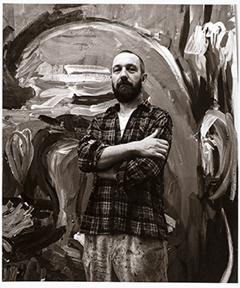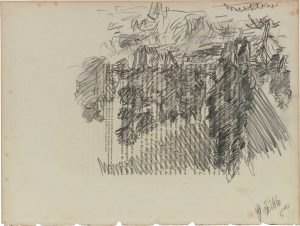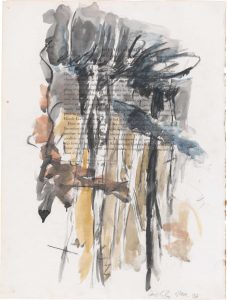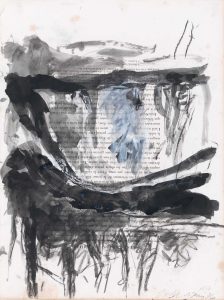ARTISTS
Born Hans-Georg Kern in 1938, Georg Baselitz grew up in Saxony, an area that later became the GDR. He studied painting at the Academy of Art in East Berlin (1956) but he was expelled after two terms for ‘political immaturity’. He then applied to study at the Academy in West Berlin and moved there in 1957, completing his studies in 1962. During this period he adopted the surname Baselitz, refl ecting his birthplace Deutschbaselitz.
In searching for alternatives to the strongly narrative art of Social Realism and abstract painting, he became interested in art considered to be outside of the mainstream of Modernism and in imagery that was rooted in the Art Brut. He was also inspired by Existentialist art and literature, by Dada and Surrealism.
In 1963 Baselitz’s fi rst solo exhibition at Galerie Werner & Katz, Berlin, caused a public scandal and two paintings were confi scated by the German authorities who claimed that they were publicly indecent.
After a scholarship in Florence in 1965, Baselitz embarked on a series of paintings depicting monumental male figures, which he described as Rebels, Shepherds or ‘New Types’. Viewed within the Romantic tradition, they are often regarded as outsiders associated with the fi gure of the artist. These paintings are often referred to as the ‘Hero’ series. Baselitz depicted his fi gures within mythical, ruined landscapes, each with symbolic attributes to identify their individual characters, often with exaggerated and exposed sexual organs. The lone fi gure as a prophet or saint also alludes to soldiers returning home from WWII.
The ‘Fracture’ paintings of the late 1960s revealed Baselitz’s keen interest in forests, rural landscapes, woodsmen and hunters. The works were divided into segments so that the imagery could be reorganised pictorially. In 1969, he decided to create and display work upside down in order to re-focus the viewer on the painterly merits of the pictures.
By attempting to overcome the representational, content-driven character of his earlier work, this also enabled him to emphasise the abstract qualities of the composition.
Since the early 1980s he has made monumental sculptures of fi gures and heads with rudimentary and deliberately irregular forms. He uses wood because “it enables avoidance of any attractiveness of form, any craft or elegance … objects in wood are unique, simple, unpretentious”. Having spent most of the early 1970s apparently working outside the mainstream, by the 1980s he had established an international reputation (cemented by exhibitions such as the Venice Biennale in 1980 and ‘A New Spirit in Painting’ in 1981). During the 1980s and early 1990s, the canvases became denser and more heavily worked, and subject matter returned to play a greater role. He began introducing motifs from Slavic folk art, sometimes combining motifs with figures of family members taken from old photographs. The subjects of German Romanticism and Socialist Realism inspired his more recent work.
In 2005 Baselitz introduced the ‘Remix’ in his work, in which he has returned to key phases of his own art history and made new versions of his work, which have allowed him to revisit and excavate the past, pushing his own painterly vocabulary to create original new works.
He lives and works in Germany and Italy.
Exhibitions and Distinctions (Selection)
2021
“Baselitz – The retrospective”, Centre Pomidou, Paris, France
2019
“Baselitz – Academy”, Gallerie dell’Accademia, Venice, Italy
2018
“BASELITZ: SIX DECADES”, Hirshhorn Museum, Washington, USA
“Georg Baselitz: Works on Paper”, Kunstmuseum Basel, Basel, Switzerland
“Georg Baselitz”, Fondation Beyeler, Riehen/Basel, Switzerland
“Georg Baselitz, The Prints 1997-2017”, Musée des Beaux-Arts le Locle, Switzerland
“Corpus Baselitz”, Musée Uniterlinden, Colmar, France
2017
“Georg Baselitz, Preview with Review”, Hungarian National Gallery, Budapest, Hungary
“Georg Baselitz, The Heroes”, Guggenheim Bilbao, Spain
“Georg Baselitz: Gli Eroi”, Palazzo delle Expozioni, Rome, Italy
2016
“The Heroes”, Städel Museum, Frankfurt, Guggenheim Museum, Bilbao, Moderna Museet,
Stockholm, and Palazzo delle Esposizioni, Rome, Italy (traveling exhibition)
“Georg Baselitz”: Die Helden, Städel-Museum, Frankfurt, Germany
“Georg Baselitz: Mit Richard unterwegs”, Druckgrafik 1996-2016, Schloss Dachau, Dachau,
Germany
“Georg Baselitz – Emilio Vedova”, Museum Küppersmühle, Duisburg, Germany
“Experiment and Renewal”, Museum Jorn, Silkeborg, Denmark
“Georg Baselitz: Malelade”, Fondation Jan Michalski, Montricher, Switzerland
2015
“Georg Baselitz: How it began. Paintings and graphical works of the last twenty years”, Marble Palace, Russian Museum, St. Petersburg, Russia
“Works from the Collection Frieder Burda, Frieder Burda Museum, Baden-Baden, Germany
2014
“Artist Rooms: Georg Baselitz”, New Walk Museum and Art Gallery, Leicester, UK
“Georg Baselitz – Damals, dazwischen und heute / Back then, in between and today”, Haus der
Kunst, Munich, Germany
“Georg Baselitz – Straßenbild”, De Pont Museum, Tilburg, The Netherlands
2013
“BDM Gruppe”, Victoria and Albert Museum, John Madjeski Garden, London, UK
“Georg Baselitz – Aus der Sammlung”, Kunstsammlungen Chemnitz, Chemnitz, Germany
“Georg Baselitz – Besuch bei Ernst Ludwig”, Kirchner Museum, Davos, Switzerland
“Georg Baselitz – Werke von 1968 bis 2012”, ESSL Museum, Vienna, Austria
“Georg Baselitz – Hintergrundgeschichten”, SMD Schloß, Dresden, Germany
“Baselitz – Tier, Landschaft, Ort”, Franz Marc Museum, Kochel am See, Germany
“Georg Baselitz, Albertina | Schausammlung”, Vienna, Austria
“Georg Baselitz – Graphik”, Kunstmuseum Heidenheim, Heidenheim, Germany
“Georg Baselitz – Remix”, Galleria Bellinzona, Milan / Grand Hotel Villa Serbelloni, Bellagio,
Italy
2012
“Romantiker kaputt”, Kunstmuseum Moritzburg, Halle, Germany
“Georg Baselitz – Berliner Jahre”, Bilder aus der Sammlung Baselitz, Villa Schöningen, Potsdam,
Germany
“Georg Baselitz – Das Naturmotiv”, Altana Kulturstiftung, Bad Homburg, Germany
Landesmuseum für Kunst und Kulturgeschichte, Prinzenpalais, Oldenburg, Germany
2011
“Georg Baselitz – Le Monde à l’envers, tel qu’il est”, Cabinet des Estampes, Liege, Belgium
“Baselitz – Sculpteur”, Musée d´Art Moderne de la Ville de Paris, MAM/ARC, Paris, France
“Georg Baselitz / Arnulf Rainer – Lustspiel, Neues aus dem Atelier”, Arnulf Rainer Museum,
Baden, Austria
“Georg Baselitz – A la pointe du trait”, Musée Cantini, Marseille, France
“Georg Baselitz – Remix”, Kunstforeningen GL Strand, Copenhagen, Denmark
“Folk Thing Zero”, Villa Borghese, Rome, Italy
2010
“Skulpturen”, Staatliche Kunsthalle, Baden-Baden, Germany
“Remix”, Helsinki Art Museum Tennis Palace, Helsinki, Finland
“50 Jahre Malerei”, Museum Frieder Burda, Baden-Baden, Germany
“Georg Baselitz : Pinturas Recentes”, Pinacoteca do Estado, São Paulo, Brazil
“Georg Baselitz – Ausstellung im Labyrinth”, Kreissparkasse, Munich, Germany
2009
“Baselitz – 50 Years of Painting / 30 Years of Sculpture”, Museum Frieder Burda, Staatliche
Kunsthalle, Baden-Baden, Germany
“Georg Baselitz, Dresdner Frauen”, Gemäldegalerie Alte Meister, Dresden, Germany
2007
Kunsthalle Würth, Schwäbisch-Hall
2003
Praemium Imperiale Tokyo. Retrospective at Art and Exhibition Hall of the Federal Republic Germany, Bonn. Laureate of the Accademia di Belle Arti, Florence
2000
Lower-Saxon State Award. Large exhibition at the Albertina,Vienna
1999
Honorary academian at the Academy of Fine Arts, Krakow
1996
Honorary professorship at Royal Academy of Arts in London Musée d’Art Moderne de la Ville de Paris
1995
Large Retrospective at the Solomon R. Guggenheim Museum in New York, Los Angeles County Museum of Arts, Hirschhorn Museum and Sculptures Garden, Washington and at Nationalgalerie, Berlin
1990
Retrospective at the Kunsthaus Zürich and Kunsthalle Düsseldorf
1986
Awarded Kaiserring (Emperor’s Ring) by the city of Goslar. Art Prize of the Norddeutsche Landesbank, Hannover
1983—1988
(also from 1992-2003) professorship at the Berlin Academy of Arts
1980
Shows his first sculpture at the German Pavillon of the Venice Biennale
1978
Professorship at the State Academy of Fine Arts in Karlsruhe
1976
Retrospectives at the Kunsthalle Bern, the Staatsgalerie of Modern Art in Munich and the Kunsthalle Köln
1970
First museum exhibition in the Kupferstichkabinett, Museum of Arts, Basel
1969
First motif reversal with Der Wald auf dem Kopf (The wood on its head)
1963
First exhibition in Werner & Katz gallery, Berlin and confiscation of his work Die große Nacht im Eimer (the big night down the drain) by the public prosecutor’s office, on grounds of sexual lewdness
Literature (Selection)
Baselitz Remix, ed. by Pinakothek der Moderne, Munich, 2006
Georg Baselitz—Paintings 1962-2001, ed. by Detlev Gretenkort, Milan, 2002
Georg Baselitz, Manifeste und Texte zur Kunst 1966—2000, Bern 2001
Georg Baselitz, ed. by Galerie Beyeler, Basel, 1992
Georg Baselitz, Andreas Frantzke, München, 1988
Baselitz—Peintre-Graveur, Werkverzeichnis der Druckgraphik, Fred Jahn, Johannes Gachnang,Vol. I: 1963—1974,Vol. 2: 1974—1982, Basel, Berlin 1983, 1987









 +49 89 29 73 42
+49 89 29 73 42